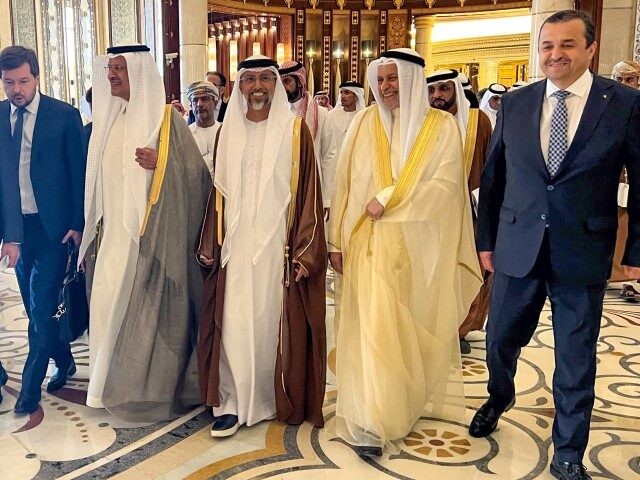OPEC+ to Extend Oil Production Cuts Through End of 2025 in Attempt to Keep Prices High
 Haitham EL-TABEI / AFP via Getty
Haitham EL-TABEI / AFP via Getty
OPEC+, the coalition of OPEC member nations and allied oil producers, announced on Sunday it would extend existing overall limits on oil production through 2025, attempting to ensure that prices do not fall below desired levels.
Some individual nations would extend their cuts according to a variety of timelines, the cartel announced, while one member, the United Arab Emirates (UAE), would increase crude oil production by 300,000 barrels per day (bpd).
Some of the cuts in place were the subject of significant international shock when imposed, particularly an October 2022 decision to cut OPEC+ production by 2 million bpd. The move prompted the administration of leftist President Joe Biden to accuse Saudi Arabia, one of the most influential members of the Organization of Petroleum Exporting Countries (OPEC), of attempting to help Russia finance its invasion of Ukraine. Russia is the leading member of OPEC+, but not an OPEC member state.
Saudi Arabia responded with outrage to Biden at the time, and Ukrainian President Volodymyr Zelensky issued a statement thanking Riyadh for its support in an indirect rebuff to the accusation.
The decision to extend the cuts has not, at press time, prompted similar ire from the White House. Oil prices also went down on Monday, which analysts attributed to the fact that OPEC+ presented an end in sight for many smaller cuts discussed at its meeting this weekend.
According to the Saudi news outlet al-Arabiya, current cuts across the OPEC+ memberships would remain in place through the end of December 2025. Those overall limits stand at around 2 million bpd, as agreed upon in October 2022.
“In addition, eight countries said they would also extend voluntary supply cuts made at Riyadh’s request to further support the market,” the network detailed: “Saudi Arabia, Russia, Iraq, United Arab Emirates, Kuwait, Kazakhstan, Algeria and Oman.”
In total, OPEC+ is cutting nearly 6 million bpd, including the individual limits. Some of the voluntary cuts are expected to end as recently as September, however.
The OPEC+ decisions appeared to drive oil prices down on Monday despite the confirmation of extended limits on production. Brent crude prices fell below $80 a barrel for the first time since February on Monday, the industry site OilPrice.com reported.
“On Monday at 11:54 a.m. ET, Brent crude was trading down 3.29% at $78.44, for a loss of $2.67 on the day,” the outlet detailed. “West Texas Intermediate (WTI) was down 3.51% at $74.29 per barrel, for a loss of $2.70 per barrel.”
Analysts suggested the explanation for the drop is that at least some of the oil production cuts are now scheduled to end in October and, outside of OPEC, the world expected America's oil output to continue breaking records. Brent crude is often used to understand the average oil price around the world, while the WTI is a closer estimate of American oil prices.
“This deal looks to draw a line under attempts to drive energy prices sharply higher for the time being,” Joshua Mahony, chief market analyst at Scope Markets, told NBC on Monday.
“While it will extend cuts for some key Opec members like Saudi Arabia and Russia well into 2025, it will also start to roll back some measures as soon as October, which is earlier than the market had expected,” another analyst, Kathleen Brooks of XTB, told NBC.
In America, production is expected to continue to soar.
“The US, the world’s largest oil and gas producer, is heading for another year of record production,” Emirati newspaper The National observed on Monday, “although with a significantly smaller increase as companies scale back activity following a wave of acquisitions in the industry, analysts have said.”
The fall in prices also accounts for expectations that oil demand will continue to increase, particularly in the world's two most populous nations, China and India. China and India are both members of the BRICS coalition, a growing group of countries attempting to establish independence from the U.S. dollar and distance themselves from America generally. BRICS also features oil heavyweights such as Russia, Iran, and the UAE, and the full membership of Saudi Arabia is pending as of early this year. Both have dramatically increased purchases of Russian and Iranian oil, though they have also leveraged their massive demand to seek the lowest prices – an irritant for Iran in particular, hobbled by decades of sanctions.
While enjoying growing demand from allied states, Russia has also lent itself to the Saudi-led effort to keep production of oil low to prevent a significant drop in prices. In December, Russian strongman Vladimir Putin assured Saudi Crown Price Mohammed bin Salman of his commitment to the plan. Visiting Riyadh, Putin signed onto a joint statement that suggested both would oppose any suggestion of increasing oil production too quickly at the OPEC+ forum.
“In the field of energy, the two sides commended the close cooperation between them and the successful efforts of the OPEC+ countries in enhancing the stability of global oil markets,” the joint statement read. “They stressed the importance of continuing this cooperation, and the need for all participating countries to adhere to the OPEC+ agreement, in a way that serves the interests of producers and consumers and supports the growth of the global economy.”
Source link

